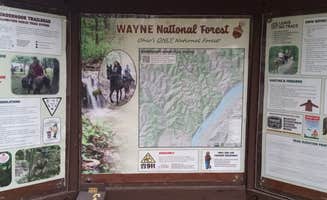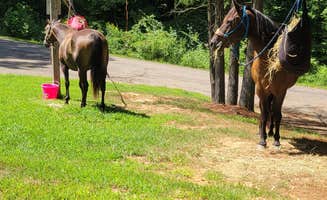Horseback riders exploring the Wayne National Forest near Waverly, West Virginia can find several dedicated equestrian campsites in the hilly terrain. The region sits at the edge of the Appalachian foothills with elevations ranging from 600-900 feet. Seasonal changes affect trail conditions significantly, with summer bringing heavy vegetation growth and spring often creating muddy trail sections.
What to do
Trail exploring on horseback: The Kinderhook Horse Trail system offers several route options of varying difficulty. "The Paw Paw trail on the other hand was very smooth, dry and wide. The trail leads to the top of the hill," notes Annika E., highlighting one of the better-maintained routes for riders.
Fishing opportunities: Nearby lakes offer good angling options during warmer months. "The fishing was good, and the activities with the naturalist (Cayden) were fun and engaging," reports Ryan W. about Blue Rock State Park Campground, which maintains a stocked fishing lake.
Geocaching adventures: Several trails contain hidden caches for tech-savvy explorers. "Lots of geocasches in the area on the trails in Wayne national forest," shares Kelsey R., who visited Burr Oak State Park with her dog and found numerous caches during their stay.
What campers like
Direct trail access: Most equestrian sites connect directly to trail systems. "Nice clean area just off main road. Can camp here in certain spots," explains Joe B. about his visit to Kinderhook Trailhead, noting the convenient placement for riders wanting early morning trail starts.
Designated horse areas: Some campgrounds offer dedicated equestrian zones. "Very quiet campground with little to no other riders around," reports Janessa S. about the Blue Rock State Park Campground — Blue Rock State Park equestrian section, though she noted some non-equestrians occasionally use the area.
Seasonal water access: Water availability varies by location and time of year. "Area is dedicated to horse trail riding... Does have a small hand pump water spigot," Joe B. mentions about Kinderhook Horse Trail, referencing the manual pump that provides water for both horses and riders during most seasons.
What you should know
Limited camping space: Many equestrian sites accommodate only a small number of trailers. "Not much area to camp. No fire rings, one picnic table. Definitely only for very small camper, car camp, or tent, small group," warns Joe B. about Kinderhook Horse Trail.
Evening traffic patterns: Some trailheads experience local vehicle movement after dark. "I've had two cars drive in after sunset who have just sat around for a bit then left. I would not recommend this site if you are traveling solo," cautions Jack H. about his experience at Kinderhook Horse Trail.
Trail maintenance varies: Trail conditions can change dramatically with seasons. "The Kinderhook trail was overgrown," observes Annika E., contrasting this with the better-maintained Paw Paw trail she rode during the same visit to Old Stone Church Campground.
Tips for camping with families
Consider alternative activities: Not all children enjoy riding all day. "We camped at both Dock 3 and Dock 2 with our dog, those are the only two areas that allow pets. At Dock 3 we were right on the water but dock 2 is probably 200 yards from the water," explains Kelsey R., noting how different sites at Burr Oak offer varied access to water-based activities.
Pack for insects: Forested areas harbor diverse bug populations. "A lot of insects, humid and dense deciduous forest surrounding the trailhead," reports Annika E. about the conditions at Kinderhook Horse Trail, suggesting families bring appropriate repellent.
Restroom facilities vary: Bathroom quality differs significantly between sites. "The bathroom was clean, but the 'non-flush' toilet was just gross," notes Harley G. about Dorr-Run Red Oak Trailhead, suggesting families with young children might want to research facilities carefully.
Tips from RVers
Site selection for horse trailers: Finding level space for both RV and horse trailer requires planning. "Easy pull-thru site for our small travel trailer. Each pull-thru is set-up for horses, but RVs are allowed (according to NFS website)," shares Tammy F. about her stay at Old Stone Church Campground.
Communication options: Cell service varies across the region. "I had good 4G ATT cell service. Worked well, with no drops. Data was a bit slower than usual but still good," reports Tammy F. about the connectivity at Old Stone Church Campground, useful information for those needing to stay connected.
Off-season considerations: Many facilities close during winter months. "Stayed one night. OHV trails closed for winter. Hiking allowed year-round. Most campsites inaccessible during off-season. Pit toilet closed for winter," warns Doug H. about his experience at Dorr-Run Red Oak Trailhead during the colder months.



